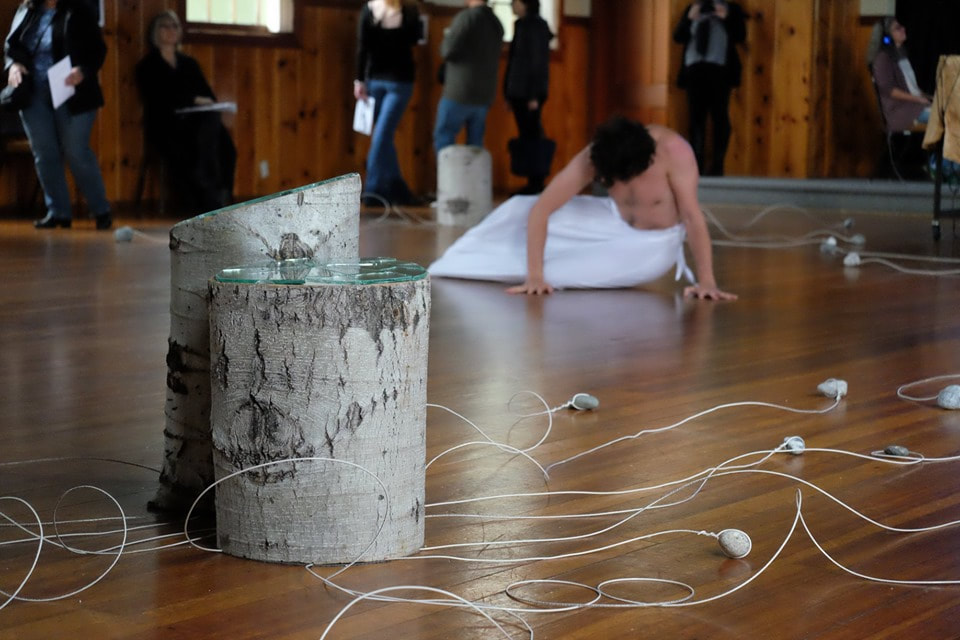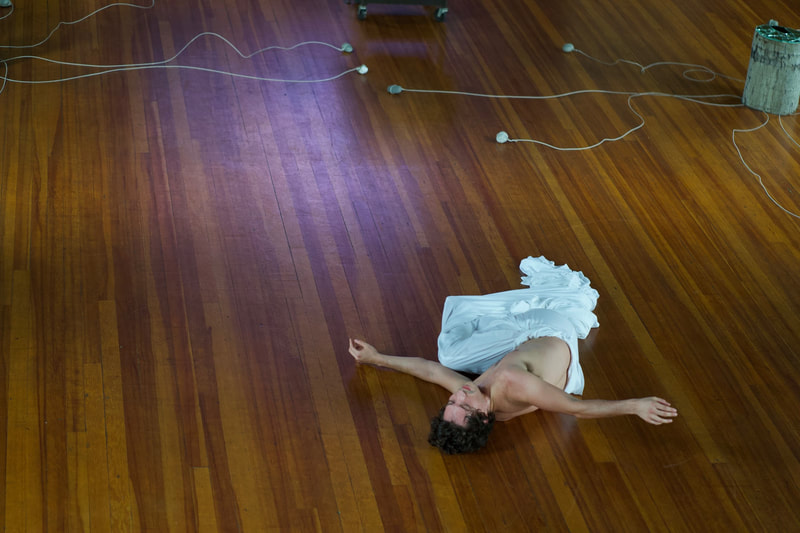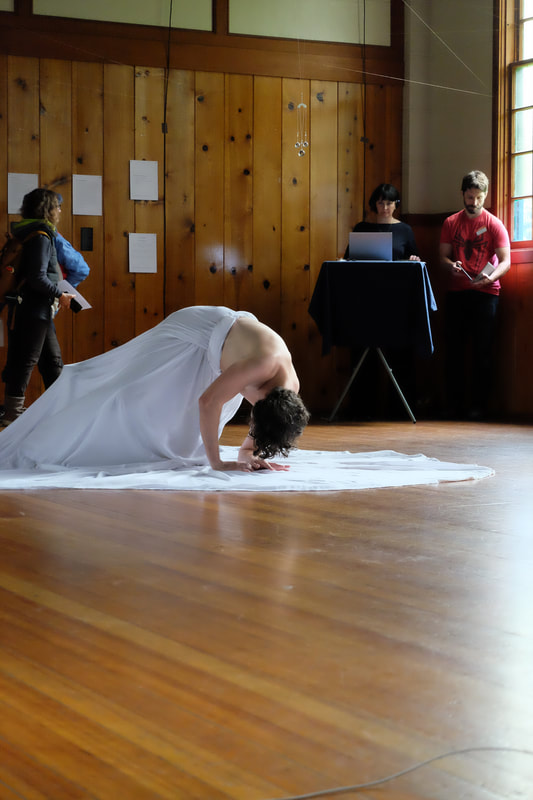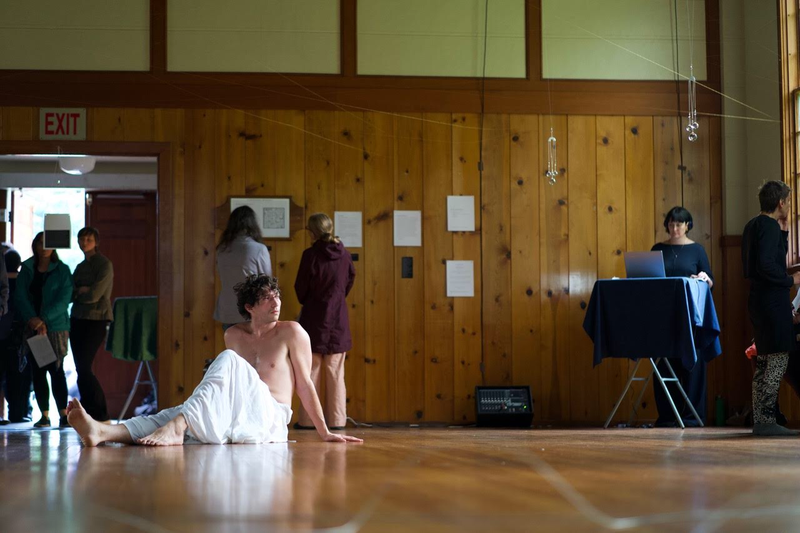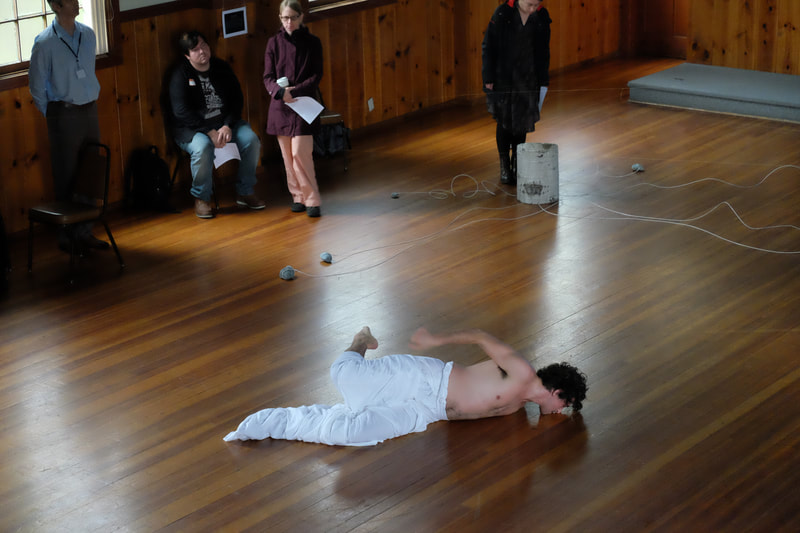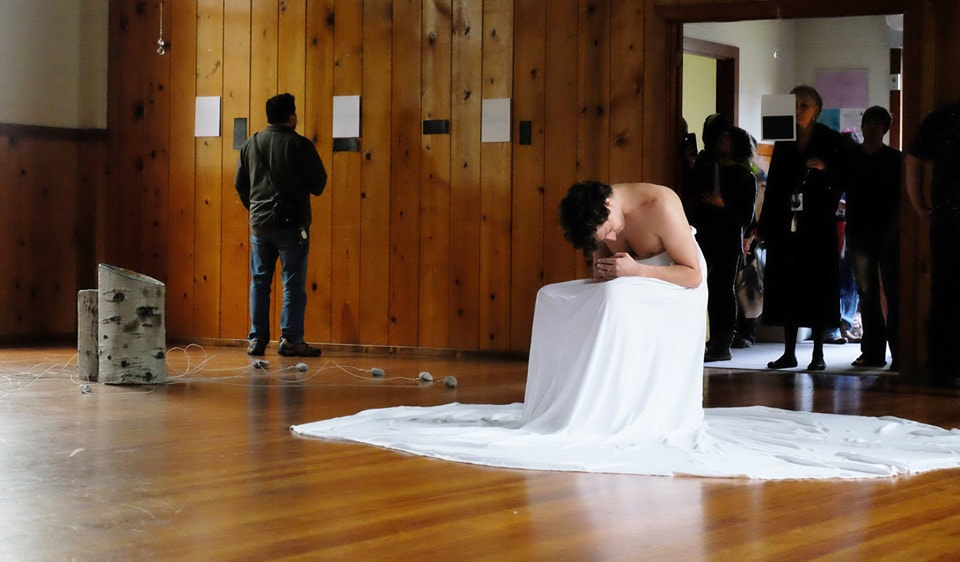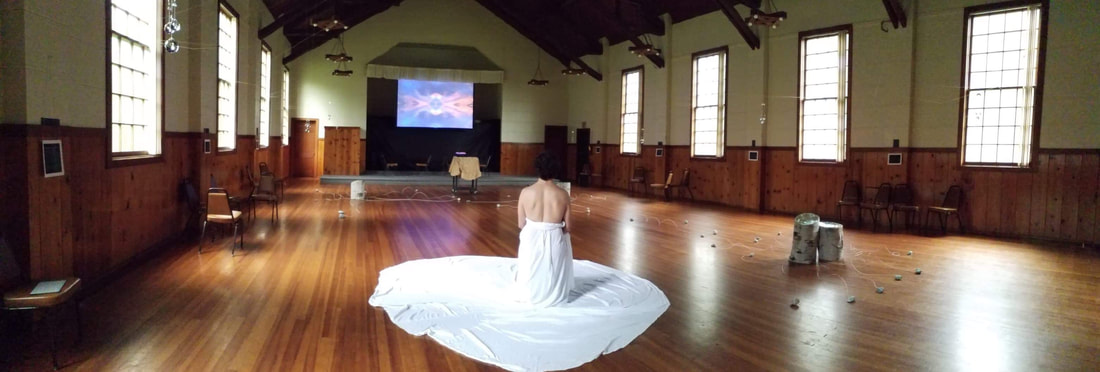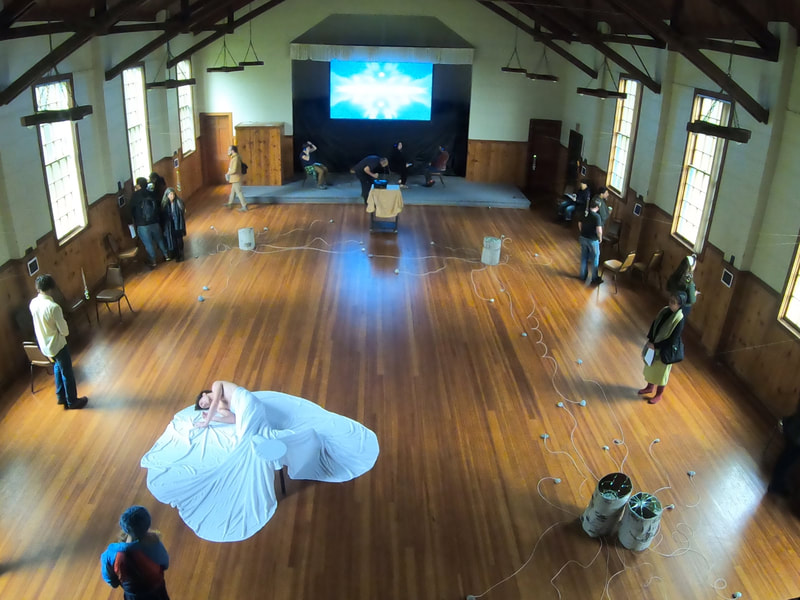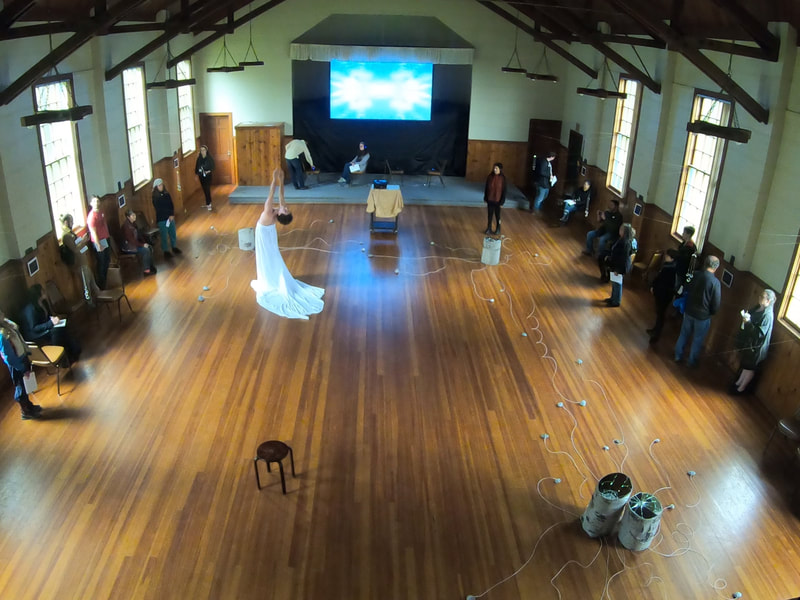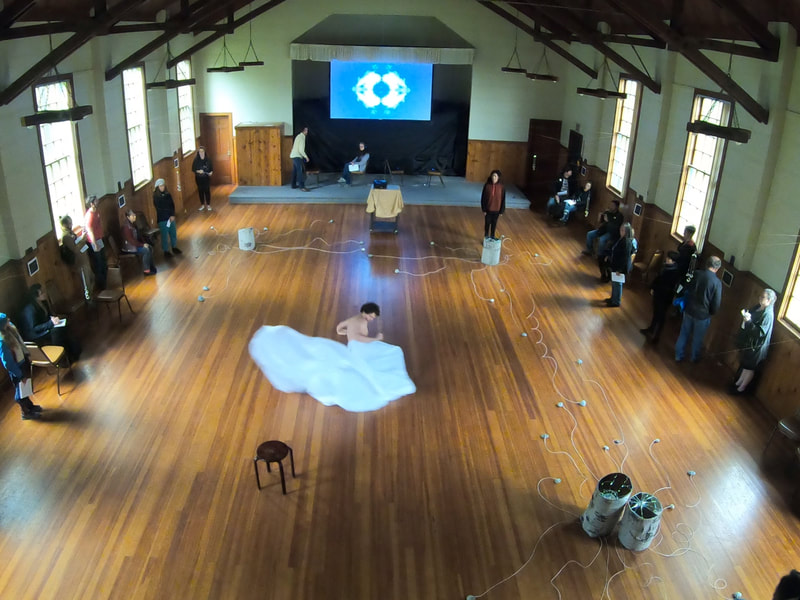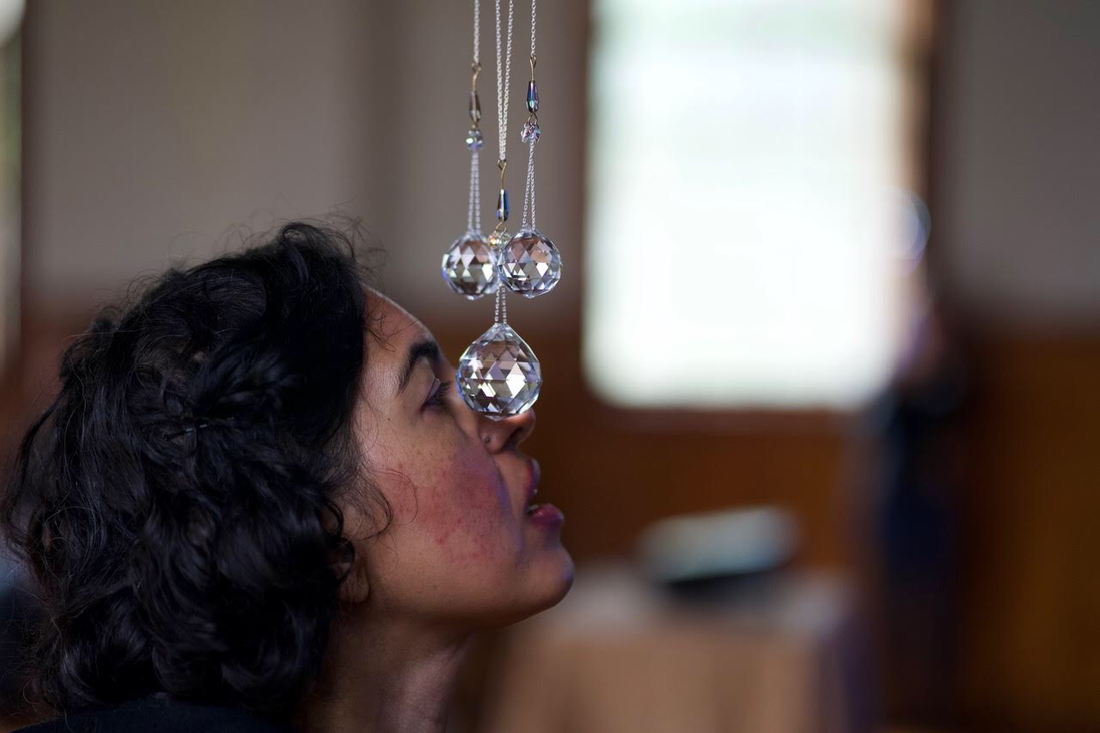Mobility is a Moment
Mobility is a Moment is an improvisational and contemplative performance by professional dance artist Daniel Mont-Eton. Daniel and Krista worked within a wide context, reflecting upon how mobility and limitations stir an awareness of how we are living moment to moment with visible and invisible limitations – personally, societally, culturally, ecologically.
Part of this work looked at mobility on a spectrum, ranging from climate migration, to cultural pressures of ableism, the ways societal privilege offers economic mobility, and how humans center their mobility over other species. These conversations intersected environmental humanities with deeply personal circumstances and Krista asked Dan to hold all of the conversations simultaneously as source material as he performed.
Part of this work looked at mobility on a spectrum, ranging from climate migration, to cultural pressures of ableism, the ways societal privilege offers economic mobility, and how humans center their mobility over other species. These conversations intersected environmental humanities with deeply personal circumstances and Krista asked Dan to hold all of the conversations simultaneously as source material as he performed.
Dance, when you're broken open. Dance, if you've torn the bandage off. Dance in the middle of the fighting. Dance in your blood. Dance when you're perfectly free."
- Rumi
|
Both artists have navigated physical injury and as part of a transitional point in Dan’s life/career, Krista curated a space for him to live in, and be with, all the change that comes with acknowledging injury, limitations, loss of future dreams, and in some ways a loss of self. How we pivot, gracefully and clumsily, into new forms as we grieve the loss of mobility, of trusting our own body, but also how we carve new shorelines for rest, listening, and healing.
On a rainy Sunday morning in late 2019, near the Salish Sea, we arrived early to a space, formerly a church, with large light filled windows. The church resided on Fort Worden, a former military base converted into a state park. Dan warmed up slowly and gently as the rain echoed on the metal roof. Krista began a sound design that he could respond to, live in. It started with white noise, the crackle of a campfire mixed with a soft mountain stream and spilled into larger a larger soundscape designed to prompt Dan as he listened, moved, responded. Dan had a full 30 minutes to sit in the space without an audience. He sat meditatively surrounded by the hemline of a large white skirt. |
Dan and Krista did not plan the movement in any traditional choreographic methods, but instead discussed how the space was an invitation for him to be present to himself, to reflect inward, to be witnessed. His extensive background as an improvisational artist made it possible to also insert a task based prompt: to stay with the trouble of becoming bound up in the skirt and spend time unspooling his feet to move again. As a supportive resource, Krista provided Dan with a series of trauma informed creative prompts to draw upon. and the audience was able to engage in those prompts as they entered the church as well.
Our task is to make trouble, to stir up potent response to devastating events, as well as to settle troubled waters and rebuild quiet places.
- Donna Haraway
I really look back at these memories, these photos, as a fluid place. It held so much … beginnings, endings, joy, hardship, and being in the middle. I met Dan in 2012, as part of performance project, and he turned a light on for me, introducing me to new movement that felt so wonderful in my broken, injured, ballet body, and he generously shared so many of the artists he was inspired by at the time, in a way he became a mentor to me. Mentors aren't always older, in fact, I think it's highly relevant to seek out younger mentors in these times. When I am patient with my work, things align - often guiding me to what I need to pay attention to. So it didn't come as a surprise how incredibly synchronistic it was that Dan's departure from his professional dance career in 2019 coincided with my research wrapping up at Goddard College. I felt so grateful to have his presence at the end of this chapter for me, which was also a beginning. We intersected for this brief performance moment in my artistic journey, but the underlying conversations that have spanned the years really came forward as I recognized how much Dan's brightness, his ability to integrate such an authenticity to his work, propelled me to seek my own. It really resonated with me that I have found a lot of trust in Dan's feedback, often sending him drafts of my work before anyone else. He has been a touchstone through out my departure from a dance culture that stifled me. Dan, just by being Dan, was a prism for me. It felt so meaningful to hold space for him as he tilted the kaleidoscope to start a new chapter in his life, and to acknowledge the sticky, messy, beautiful, poetic, sorrowful, and joyful ways change touches us.
- Krista Leigh Pasini
An audience member reflected entering the space was like walking into a dream, as though the world had ended, but everything, everyone, was okay. Dan's flight like movement and the twisted up knots he would become entangled in became incredibly poetic, fraught, and poignant. “Somewhere between watching a swan die and a foal being born” someone observed.
Chasing Light | Prismatic Thinking
|
Thomas Edison developed a term, Kaleidoscope Thinking, over a century ago and as part of Krista's undergraduate work in history and political science her professors encouraged their students to look at historical story, narrative, and events with the same intention. If we tilt the lens of a kaleidoscope, the crystals inside re-settle to make a completely new arrangement within the same construct. This is a helpful resource when discussing historical events that often look narrowly at point in history from one perspective.
Krista employs this technique to her art making and considers her art work to be in a constant state of re-arrangement. This allows the inquiries to remain porous to the moment, to the artists responding, and to her own interest: to look at a question, a moment, anew. She re-named her process Prismatic Thinking to include her trauma informed and joy practices that often wrap around the artists she works with so they have a container to work that feel supportive and safe. |
Perhaps I should say that documenting is when you add thing plus light, light minus thing, photograph after photograph; or when you add sound, plus silence, minus sound, minus silence. What you have, in the end, are all the moments that didn’t form part of the actual experience. A sequence of interruptions, holes, missing parts, cut out from the moment in which the experience took place … The strange thing is: if, in the future one day, you add all those documents together again, what you have, all over again, is the experience. Or at least a version of the experience that replaces the lived experience, even if what you originally documented were the moments cut out from it.
- Valeria Luisselli
Historical Context | Source Material
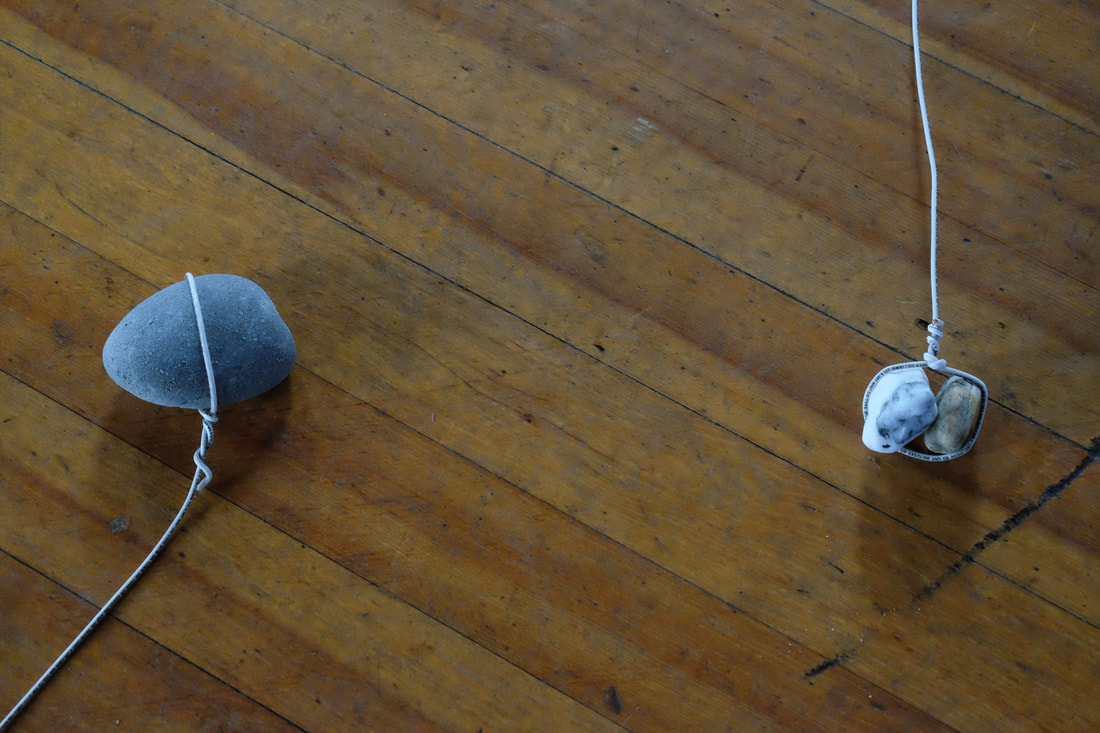 mixed media sculpture Mike Pasini
mixed media sculpture Mike Pasini
Mobility is a Privilege
Using a wider context informed by sections of Krista's graduate research, Dan's performance offered a performative interpretation and invited the audience to be on an individual and collective journey with their own interpretations. In the months leading up to the performance, Krista provided Dan with source material from her research so that he could intersect his personal experience with inquiries from her work. This included not just the work from the Breaking Classical series, but a summation of all her graduate work. One of the projects that came forward as an important crossover was a site specific project titled Last Best Place Conversations with Montana which included a critical essay on white privilege titled Mobility is a Privilege. The intersections of how unrestrained extractive practices and colonization overlapped with personal inquiries relating to how we extract resources from ourselves, each other, spoke to how we individually and collectively lose mobility. This prismatic lens held both the questions presented in Breaking Classical as well as the larger questions of environmental humanities and eco-politics.
Using a wider context informed by sections of Krista's graduate research, Dan's performance offered a performative interpretation and invited the audience to be on an individual and collective journey with their own interpretations. In the months leading up to the performance, Krista provided Dan with source material from her research so that he could intersect his personal experience with inquiries from her work. This included not just the work from the Breaking Classical series, but a summation of all her graduate work. One of the projects that came forward as an important crossover was a site specific project titled Last Best Place Conversations with Montana which included a critical essay on white privilege titled Mobility is a Privilege. The intersections of how unrestrained extractive practices and colonization overlapped with personal inquiries relating to how we extract resources from ourselves, each other, spoke to how we individually and collectively lose mobility. This prismatic lens held both the questions presented in Breaking Classical as well as the larger questions of environmental humanities and eco-politics.
Chasing Light | The Dress Looks Nice on You
Other source material came from an improvisational series Dan shared in 2015 called Chasing Light which was inspired from a prompt to explore light. In the series, Dan wore a white skirt in a dark studio moving in and out of a band of natural light coming in through a window.
Music: Sufjan Stevens The Dress Looks Nice on You
Other source material came from an improvisational series Dan shared in 2015 called Chasing Light which was inspired from a prompt to explore light. In the series, Dan wore a white skirt in a dark studio moving in and out of a band of natural light coming in through a window.
Music: Sufjan Stevens The Dress Looks Nice on You
